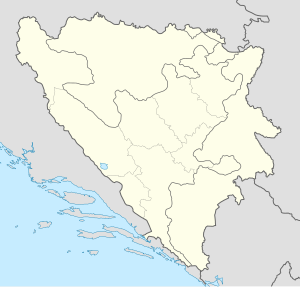Pale, Bosnia and Herzegovina
Coat of arms | |
| Latitude | 43.82°N |
| Longitude | 18.57°E |
| Mayor | ? |
| Surface (km²) | ? |
| Population (2003) |
6,900 |
| Time zone (UTC) | UTC+1 Central European Time |
Pale (Serbian Cyrillic: Пале) is a town and a municipality in Republika Srpska, Bosnia and Herzegovina, located northeast of Bosnia's capital Sarajevo. The municipality of Pale is one of the municipalities of the City of Istočno Sarajevo.
History
Pale was known as the de facto capital of Republika Srpska during the Bosnian war, as the Constitution of Republika Srpska sets out that Sarajevo is the capital of Republika Srpska. The de facto capital has now transferred to Banja Luka.
Prior to the Dayton Peace Accord, Pale was a remote suburb of Sarajevo; following the population redistribution on the basis of ethnicity in Bosnia during and after the Bosnian War, it began to more closely resemble a proper town, which it does, today.
Population
In the census of 1991, the Municipality of Pale had 16,310 residents, including:
- 11,269 Serbs (See: Serbs of Bosnia and Herzegovina)
- 4,356 Muslims by nationality (Bosniaks)
- 394 Yugoslavs
- 126 Croats
- 165 others
The town of Pale itself had a population of 6,797, including:
- 4,915 Serbs
- 1,438 Muslims by nationality (Bosniaks)
- 271 Yugoslavs
- 88 Croats
- 85 others
The pre-war Bosniak part of the Pale municipality known as Pale-Prača is now in the Federation of Bosnia and Herzegovina (the Bosnian Podrinje Canton).
Today there are about 30,000 inhabitants in Pale, many of them Bosnian Serbs that moved from Sarajevo.
Name and geography
Pale is additionally referred to by its Serb inhabitants, and in fact by many of the inhabitants of the Republika Srpska (Serb Republic), as 'Srpsko Sarajevo', or 'Serb Sarajevo'. However, there is a fair amount of distance between the borders of the actual city of Sarajevo and Pale itself (albeit less than 10 km). Pale continues to be referred to as Serb Sarajevo due to the fact that, after the Dayton Peace Accords, Sarajevo-proper was designated as belonging to the Muslim-Croat Federation, but Bosnian Serbs, having lived in Sarajevo for generations themselves, wanted to retain some claim to their city. As a result, in an attempt to echo belonging to Sarajevo, and stake some claim to it, Pale, the closest Serb settlement to Sarajevo (within the Serb Republic), became known as and referred to as Serb Sarajevo, albeit with a hint of sarcasm by many people, without regard to their ethnicity. The town is, in reality, removed geographically from the city of Sarajevo and shares no metropolitan features with the city itself. It is home to its own post office, University buildings, etc.
It should be noted that 'Serb Sarajevo' is also used to designate the area of Sokolac Region that is closest to Sarajevo.

